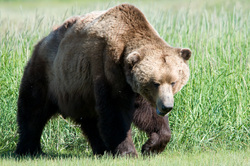
Brown Bear
By all indications, bears are extremely intelligent and most have individual personalities.
By all indications, bears are extremely intelligent and most have individual personalities.
-
Size
Up to 1,500 lbs -
Distribution
Brown bears occur throughout Alaska except on islands south of Frederick Sound in southeast Alaska, west of Unimak in the Aleutian Chain, and Bering Sea islands. -
Diet
Omnivorous -
Predators
Other Brown bears -
Reproduction
Twins are most common, but litter sizes can range from 1 to 4 -
Remarks
Can be a wide range of colors -
Other names
Brown and grizzly are both used in Alaska
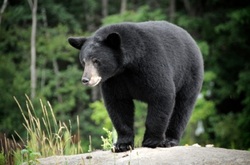
Black Bear
Bluish-colored black bears called glacier bears are found in Southeast Alaska.
Bluish-colored black bears called glacier bears are found in Southeast Alaska.
-
Size
up to 350 pounds -
Distribution
Occur over most of the forested areas of the state; not found on the Seward Peninsula, the Yukon-Kuskokwim Delta, or north of the Brooks Range. Also absent from Kodiak, Montague, and Hinchinbrook Islands, and from the Alaska Peninsula beyond Lake Iliamna. -
Diet
Omnivorous. -
Predators
Other bears, usually brown. -
Reproduction
Twins are most common, but litters may contain 1-4 cubs. -
Remarks
Black bears are the most abundant and widely distributed of the three species of North American bears; they have been recorded in all states except Hawaii.
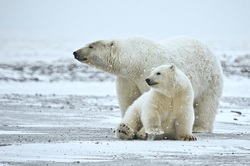
Polar Bear
Polar bears do not undergo true hibernation.
Polar bears do not undergo true hibernation.
-
Size
Males: 600–1200 lbs. 8–10 ft.; Females: 400–700 lbs. -
Lifespan
25 years -
Distribution/Range
Circumpolar, northern hemisphere only -
Diet
Ringed seals, bearded seals, walruses, beluga whales -
Predators
Male polar bears, and Alaska Native hunters -
Reproduction
2 cubs once every 3 years
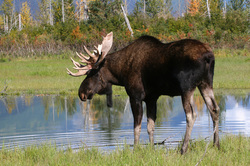
Alaskan Moose
Moose are an important source of food for Alaskans, and at least 7,000 moose are harvested annually in Alaska, amounting to about 3.5 million pounds of meat.
Moose are an important source of food for Alaskans, and at least 7,000 moose are harvested annually in Alaska, amounting to about 3.5 million pounds of meat.
- Size
Up to 1,600 pounds - Distribution
Generally associated with northern forests; found in Alaska from the Unuk River in Southeast to the Colville River on the Arctic Slope. - Diet
Herbivorous, eating willow, birch, and aspen leaves and twigs, along with sedges, Equisetum, pond weeds, and grasses. - Predators
Wolves, black bears, and brown bears - Reproduction
Usually one calf is born, but twins can occur if food has been plentiful
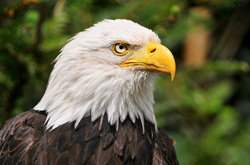
American Bald Eagle
The bald eagle builds the largest nest of any North American bird, up to 8 feet across and weighing as much as a ton.
The bald eagle builds the largest nest of any North American bird, up to 8 feet across and weighing as much as a ton.
-
Size
The bald eagle is Alaska’s largest resident bird of prey with a wing span up to 7 1/2 feet (2.3 m) long and weights of 8 to 14 pounds (3.6-6.4 kg). Like many raptors, females are larger than males. -
Range/Distribution
Bald eagles are often found along Alaska’s coast, offshore islands, and Interior lakes and rivers. The highest nesting densities occur on the islands of Southeast Alaska. The total population is estimated at 30,000 birds. -
Diet
Fish are the main diet of the bald eagle. Eagles are opportunistic and also prey upon waterfowl, small mammals, sea urchins, clams, crabs, and carrion. -
Reproduction
In late April, two eggs are laid several days apart. Incubation lasts about 35 days. When the young hatch, the weaker, usually younger, chick is killed or starved. The surviving young leave the nest after approximately 75 days.

King Salmon (Chinook)
3% of Chinook have white meat.
3% of Chinook have white meat.
- Size
Length = 36 inches (Record: 58 inches); Weight = 30 lbs (Record: 126 lbs). - Lifespan
3 to 7 years - Distribution/Range
North America "– Monterey Bay, CA' to the Chukchi Sea. Asia – Hokkaido, Japan to Anadyr River, Siberia - Diet / Feeding Type
Plankton, insects, amphipods, and fish - Predators
Birds and fish eat juveniles; marine mammals eat adults - Reproduction
Anadromous and semelparous - Remarks
Official state fish of Alaska - Other Names
Chinook, chins, king. quinnat, tyee, tule, blackmouth, and spring salmon.
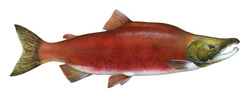
Killer Red (Sockeye Salmon)
The striking orange color of sockeye salmon flesh comes from eating plankton and krill while in the ocean.
The striking orange color of sockeye salmon flesh comes from eating plankton and krill while in the ocean.
-
Size
Length = 24 inches (Record: 31 inches); Weight = 6 lbs (Record: 16 lbs). -
Lifespan
3 to 7 years -
Distribution/Range
North America "– Klamath River, OR to the Chukchi Sea. Asia – Hokkaido, Japan to Anadyr River, Siberia -
Diet
Zooplankton,small crustaceans, small fish -
Predators
Marine mammals, bears -
Remarks
The most economically important species of salmon in Alaska -
Other Names
Red and blueback salmon, kokanee (landlocked form in lower 48 states and Canada) -
Stock Status
3rd most abundant species of Pacific salmon. Populations currently healthy in Alaska. Human induced habitat loss and direct mortality has depressed populations in the lower 48 states.
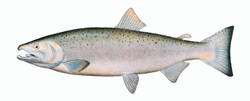
Silver (Coho Salmon)
Coho spawn primarily occurs at night.
Coho spawn primarily occurs at night.
- Size
24-30 inches long, 8-12 pounds - Range/Distribution
The traditional range of the coho salmon runs from both sides of the North Pacific Ocean, from Japan and eastern Russian, around the Bering Sea to mainland Alaska, and south all the way to Monterey Bay, California. Coho salmon have also been introduced in all the Great Lakes, as well as many other landlocked reservoirs throughout the United States. - Diet
Aquatic insects, fish, squid - Predators
Whales, sharks, marine mammals, birds, mammals, humans - Reproduction
Deposit 2,400-4,500 eggs in freshwater from September-February - Other Names
silver salmon
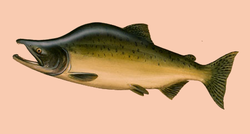
Humpy (Pink Salmon)
There are more pink salmon than any other wild Pacific salmon.
There are more pink salmon than any other wild Pacific salmon.
-
Size
18”- 25” long and between 3- 5.5 lbs -
Diet in freshwater
Adults returning to spawn do not eat. Young salmon migrating to the ocean may eat aquatic insects and zooplankton. -
Diet in saltwater
Plankton, marine shrimp and krill, other smaller fish, squid, and the occasional aquatic insect. -
Predators
Anything larger than them including killer whales, bears, birds, and humans just to name a few. -
Reproduction
A female lays between 1,200 and 1,900 eggs during spawning June through late October. Eggs incubate over winter for 5-8 months and hatch in late winter or early spring. Fry migrate to saltwater as soon as they emerge from the gravel. They feed for 18 months in the ocean, and return to spawn and die at two years of age. -
Ocean-Phase Identifying Characteristics
Mouth is white with a black gum line
Very small or almost no teeth, and no “teeth” on the tongue
Large oval spots on both lobes of tail
Large black spots on back
Pointed lower jaw
No silver on tail
Very small scales compared to other salmon that are of similar size -
Remarks
The Alaska Department of Fish and Game manages pink salmon in fresh waters of the state and in saltwater up to 3 miles from shore. -
Other names
Humpback salmon, humpy
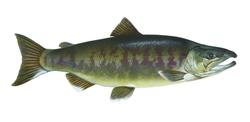
Chum Salmon
Fossils demonstrate that Pacific salmon have existed for at least 6 million years.
Fossils demonstrate that Pacific salmon have existed for at least 6 million years.
-
Size
Average 24-28 inches and 10-13lb; males usually larger than females -
Range/Distribution
Chum salmon range throughout Alaska, but are scarce north of Kotzebue Sound. While at sea, most of Alaska’s chum salmon remain in the eastern Chukchi and Bering seas and the Gulf of Alaska. -
Diet
Insect larvae, copepods, tunicates, mollusks and a variety of fishes -
Predators
Marine mammals, birds, bears, wolves, humans -
Reproduction
Spawn only once before dying -
Other Names
dog salmon, calico salmon
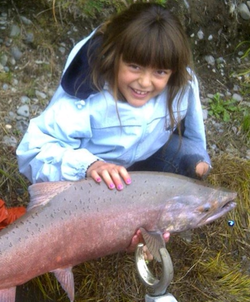
Everyone fishes in Alaska ...
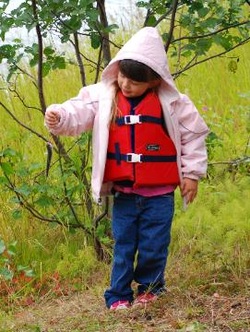
Even the tots! Children learn about fish and how to fish by fourth grade.
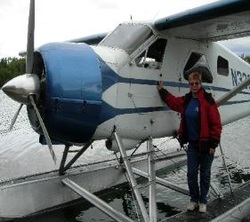
Alaskan transportation - Beaver
Everyone should have one of these if you live in Alaska. :)
Everyone should have one of these if you live in Alaska. :)
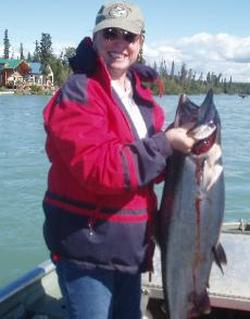
King Salmon fishing on the Kenai River.